A couple of weeks ago, I had the privilege of guiding a few good friends on a three day weekend wildlife viewing adventure. We spent the time camping, hiking, enjoying each other’s company and experiencing some fantastic wildlife viewing. I have to admit that for me a weekend like this is usually about enjoying the friendship and fellowship of great friends. However, this weekend was so much better because of the wildlife viewing experience that was to unfold before us.
To be honest, I have spent a great deal of time camping, backpacking/hiking, kayaking and more in the wilderness. So viewing wildlife in their natural surroundings is nothing new to me or the guys I was hanging with this weekend. I have had the privilege of viewing hundreds of elk grazing in high mountain meadows in the New Mexico Rockies; watching alligators and wild boars rest next to each other in the swamps of Florida; bobcats chasing rabbits through the pine thicket of central Georgia and so much more. But this weekend was different. I had heard that at Pocosin Lake National Wildlife Refuge was simply amazing for waterfowl viewing. However none of the stories of thousands of snow geese and tundra swans on the lake prepared me for what we experienced that weekend.
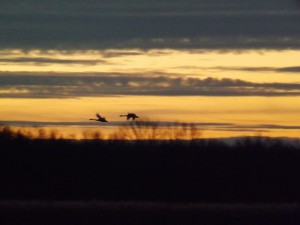

This weekend we were camping at Goose Creek State Park, so getting up on Saturday morning was challenging, especially with the frosty 25 degree temperatures that morning. We were up at 5:30 am and out the front gate of the park by 6:00 to make the 45 minute drive to the refuge. We got to the refuge just as the sun was rising to unfold a spectacular sight of duck, snow geese and tundra swans all over the impoundments around Pungo Lake. No matter where you looked, there was waterfowl by the hundreds. As the sun was rising in the east, you could see the waterfowl taking off in one location and then landing in others. There were birds sitting in the water, birds standing on the ice covered ponds, birds flying left and right, and birds circling overhead. Wow, it was amazing seeing hundreds of birds all within the first few minutes after dawn.
This was so cool! No matter what wildlife blind or water impoundment we stopped at, there was waterfowl everywhere. Later this morning, we hopped back into the trunk and headed to the northern side of Pungo Lake to explore. We stopped at the junction of two dirt roads, one of them was blocked off and parked on the side. We had about a mile walk down this road to the two wildlife blinds on the north side of the lake. So we headed out with our cameras and binoculars to see what we could see. As we walked, we started seeing tracks of deer, raccoon, coyote, large bear and other animal tracks we were not familiar with. Soon we started seeing scat from these same bear that had left the tracks on the road. And I don’t mean just once stack of scat; I mean lots of bear poo all over the place.
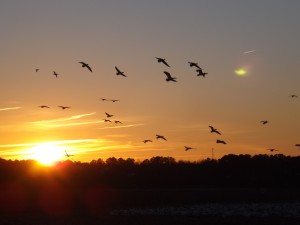
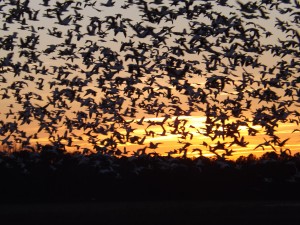
Soon one of the guys in our group stops and points to something across the field that we were walking along. Off in the distance we spot a huge momma bear with two cubs lumbering across this field about 400 yards away. We watched these bears for about 10 minutes as they worked their way across this plowed under corn field. This was simply amazing to watch these beautiful bears as they worked their way across this field. About 10 minutes later, just as we started off again, we spotted another bear crossing the road behind us. Four bear spotting within 20 minutes; wow! Later that morning we learned that black bear in eastern North Carolina typically don’t hibernate due to the milder winters and significant and consistent food sources in the area.
We spent the rest of the morning and early afternoon viewing bald eagles, coopers hawks, coots, teal ducks, and American Black Ducks. We began to think that it could not get much better. To be honest, I think we could have called this a day and been quite content. But then we had heard about something that would blow our socks off. During this time of the year, each evening you could watch thousands ff snow geese and tundra swans flying in to one specific field to feed. This took place in a couple of the refuge’s plowed under corn fields; located on the southern end of the refuge. After talking about it, we decide that we might as well as hang around to see what happens. So we pulled up to spot we were told about and waited.
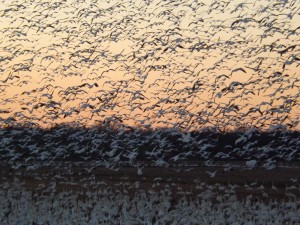

The first 45 minutes were extremely slow. There were geese and swans in the field feeding but they were all on the opposite side of this VERY LARGE field. As it started getting dark we started hearing the snow geese fly in from the north. The next 30 minutes were not disappointing to us at all. Even now I am still not fully able to put into words what we experienced that evening. I think we all have read and heard stories of hundreds of thousands of bird flying so thick that you could not see the sky. Lewis & Clark even talked about this in their journals. This was one of those moments. Over the next 30 minutes hundreds of thousands of snow geese flew into this field right before us.
As they flew in the field; two things astounded me the most about this event. The first was the noise of these geese. The sound of hundreds of thousands of birds flapping their wings at the same time and so close to each other reminded us of the sound of a jet engine starting up. You could hear this even over the sound of all the honking of these geese. The second thing was that these birds kept coming in! There were birds that were flying so high up in the sky; they looked like small specks of pepper floating in the sky. These birds circled down and down until they landed in the middle of the flock of birds on the ground, not the edges. Once they landed, the feeding started and did not stop. Think about it; this was one mass of snow geese, with their heads down, all feeding at once.
This was truly a once in a life time event for me. I stood there almost speechless not knowing what to say, snapping photo after photo, wondering how to explain this event. There was about 5 to 10 minutes that we did not have that many birds land. I guess we figured they would hang around longer, but just at dark thirty, they all took off. Within 10 minutes every bird in this field took off leaving this field almost emptied. All of these 100,000+ birds took off! Think about it, a field with this many birds all taking to wing at once! Amazing!
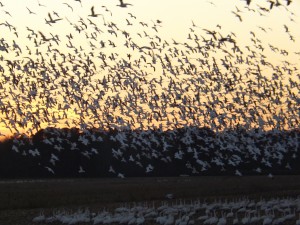
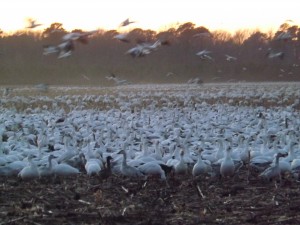
That evening sitting around the camp fire the four of us talked about what we had experienced that day. We looked at pictures that we had taken and the videos. It was hard to believe what we had seen. We all agreed that this was something special and were amazed that we had not heard of this before, especially living here in eastern North Carolina like we do. One thing we all agreed on was that we had to bring our families to witness this event in the future.
Don & Diane Harty own Mahanaim Adventures. They specialize in helping families and groups to have “Positive & Memorable” outdoor adventures. Whether these are wildlife view adventure, camping adventure or a simple kayaking adventure. They provide kayaking adventures on Town Creek, Cape Fear River, Fort Fisher Basin, Masonboro Island, Black River, Holly Shelter Creek and Moores Creek. Contact them at www.mahanaimadventures.com for more information about all of their adventures.









